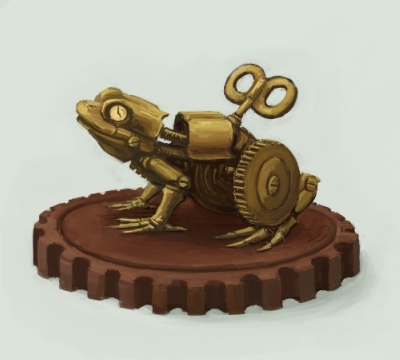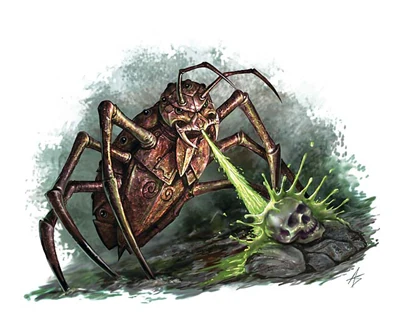 |
| Clockwork frog by ClockworkFrog. |
I have a clockwork robot character class. I have a talking animal character class. The next step seems pretty damn obvious.
Not all of the Brass Folk are built in humanoid shape, although most are. But sometimes someone installs a Brass Man brain in a different body: the body of a Bronze Horse, for example, or the body of a Mechanical Messenger Monkey, creating a clockwork robot with human-level intelligence housed inside a non-human body. Even weirder custom jobs are possible: mechanical dogs, mechanical octopi, mechanical insects... whatever you can tinker up, really. The more conservative Brass Folk disapprove of such experimentation, insisting that the Cogwheel Sage gave them human shapes for a reason, and that each new generation should imitate her prototypes as closely as possible; but many others, especially those whose association with the Steel Aspirants has given them a rather freewheeling approach to radical body modification, take a more liberal attitude. If a given Brass Man or Woman decides they wants their 'child' to be a giant mechanical frog, what business is that of anyone else?
So here are the rules for playing them.
All Clockwork Beasts have the following traits:
- You gain a bonus to all your to-hit rolls equal to your level.
- You gain 1d8 hit points per level (except large clockwork beasts - see below).
- The whirring and clanking of your heavy brass body makes a hell of a lot of noise. Your enemies are never surprised, and you always fail any attempts to move silently.
- You do not need to eat, drink, or sleep, and you are immune to poison and disease.
- You need winding up in order to function. All clockwork beasts have steam-powered auto-winders, normally built directly into their bodies at a point where they can easily reach it with their paws or mouths; when fed a supply of wood or coal, these auto-winders will spin rapidly, turning the beast's key in the process. They must sit still during the winding, or else they risk damaging their delicate internal machinery. One hour's auto-winding will power three hours of activity. If fuel for it is unavailable, the key may be turned by hand, but doing this takes six times as long, is amazingly boring, and risks causing strain injuries. For obvious reasons, they cannot wind themselves up.
- When you have been wound for a number of hours equal to your Constitution score (thus permitting three times your Constitution score in hours of continuous activity), your main-spring is fully wound and further winding has no effect. If you reach the end of your 'powered' time without having a chance to rewind, you can stumble on for one extra hour, getting slower and slower: you have -4 Dexterity and Strength during this time. At the end of this extra hour, you shut down entirely until rewound.
- Your paws (or tentacles, or whatever) can be unscrewed and replaced with a pair of human-like clockwork hands which you carry with you, allowing you to perform tasks requiring opposable thumbs. Unscrewing one paw and replacing it with a hand (or vice versa) takes five minutes. (This is to ensure that the clockwork beast can eventually build itself clockwork 'offspring', if it so desires. Building a beast without access to hands would be like deliberately sterilising your child at birth.)
- You do not feel pain. Normal healing does not help you, but as long as you have your hands on you can repair yourself when damaged, regaining 1 HP per day for field repairs carried out on the march, and 3 HP per day for a day spent doing nothing else. These numbers each rise by 1 if there is someone with a technology bonus of 3 or higher around to lend a hand.
- If you are reduced to 0 HP, you are too badly damaged to be repaired in the field, but with the right tools and expertise you can still be repaired in a well-equipped workshop, and will retain your memories and personality unless your clockwork brain has also been damaged or destroyed.

Large clockwork beasts (e.g. clockwork lions, clockwork bears, clockwork horses, etc) have the following additional traits:
- You must have a strength and constitution of at least 12 to play a large clockwork beast.
- You cannot use weapons or armour, but you have a natural AC of 15, and inflict 1d8 damage with your huge, heavy claws. (You can have a gun built into your body, but unless you have your hands on you'll need someone else to reload it.)
- You gain 1d10 hit points per level instead of 1d8.
- You are huge, heavy, and enormously strong: capable of smashing light wooden buildings and furniture to splinters, and doing serious damage to heavier ones. A man-sized character could ride you. A swivel gun could be mounted on your back. (You couldn't fire it, though.) You can smash anything that a large metal animal should be able to smash, with no roll required.
- You can carry four times as many objects as a human with the same strength score.
- You gain a +1 bonus to technology rolls.
Smaller clockwork beasts (e.g. clockwork wolves, giant clockwork rats or mice, etc) have the following additional traits:

- You cannot use weapons or armour, but you have a natural AC of 14, and inflict 1d6 damage with your metal teeth and/or claws. (You can have a gun built into your body, but unless you have your hands on you'll need someone else to reload it.)
- You can run twice as fast as a human, although doing this unwinds your spring at double normal speed. (If you are a clockwork frog or similar amphibious design, this is replaced by an ability to swim at double normal speed.)
- You gain a +1 bonus to REF saves.
- You gain a bonus to technology rolls equal to half your level, rounded up.

Clockwork insects (e.g. clockwork spiders, giant clockroaches, etc) have the following additional traits:
- You cannot use weapons or armour, but you have a natural AC of 13, and inflict 1d4 damage with your metal fangs. (You can have a gun built into your body, but unless you have your hands on you'll need someone else to reload it.)
- Your legs end in sharp metal hooks, allowing you to climb along walls or ceilings as easily as the floor.
- You gain a +2 bonus to REF saves.
- Once per day per level, you can use your bite to inject a dose of corrosive venom, inflicting an extra 2d6 damage (FORT save for half).
- You gain a bonus to technology rolls equal to half your level, rounded up.
 |
| Clocktopus by Westfalia miniatures. |
Clockwork octopi have the following additional traits:
- You cannot use armour, but you have a natural AC of 14, and inflict 1d6 damage with your metal tentacles. You can also use these tentacles to wield melee weapons and/or shields, but you cannot make a weapon attack and a tentacle attack in the same round. (You can have a gun built into your body, but unless you have your hands on you'll need someone else to reload it.)
- You can swim twice as fast as a human, although doing this unwinds your spring at double normal speed. You can also climb just about anything that will support your weight.
- In an emergency you can just flip out and start thrashing your metal tentacles around randomly. Everyone within 5' of you must make a REF save or take 1d6 damage, and any fragile inanimate objects nearby will be smashed to pieces.
- You gain a +1 bonus to technology rolls.
No comments:
Post a Comment